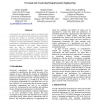RE
2005
Springer
14 years 9 months ago
2005
Springer
A reverse engineering process aims at reconstructing el abstractions from source code. This paper presents a novel reverse engineering methodology for recovering stakeholder goal ...
RE
2005
Springer
14 years 9 months ago
2005
Springer
Defect reports generated for faults found during testing provide a rich source of information regarding problematic phrases used in requirements documents. These reports indicate ...
RE
2005
Springer
14 years 9 months ago
2005
Springer
A framework for requirements analysis is proposed that accounts for individual and personal goals, and the effect of time and context on personal requirements. The implications of...
RE
2005
Springer
14 years 9 months ago
2005
Springer
This paper describes the requirements handling process of a set of research projects, the ATHENA IP, and how this process is supported by modeling and visualizing requirement stru...
RE
2005
Springer
14 years 9 months ago
2005
Springer
View merging is an important activity in any conceptual modeling language. It is often desirable to combine a set of views to gain a unified perspective, to test hypotheses about...
RE
2005
Springer
14 years 9 months ago
2005
Springer
View merging, also called view integration, is a key problem in conceptual modeling. Large models are often constructed and accessed by manipulating individual views, but it is im...
RE
2005
Springer
14 years 9 months ago
2005
Springer
RE
2005
Springer
14 years 9 months ago
2005
Springer
RE
2005
Springer
14 years 9 months ago
2005
Springer
The importance of assumptions in Requirements Engineering has long been recognised. However, to the best of our knowledge, no quantitative models for the relation between assumpti...
RE
2005
Springer
14 years 9 months ago
2005
Springer
This paper describes the use of Obstacle Analysis to identify anomaly-handling requirements for a safetycritical, autonomous system. The software requirements for the system evolv...

